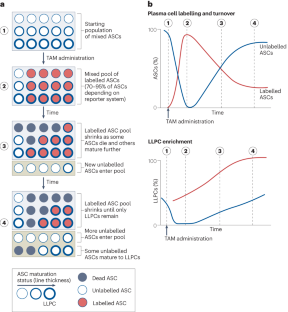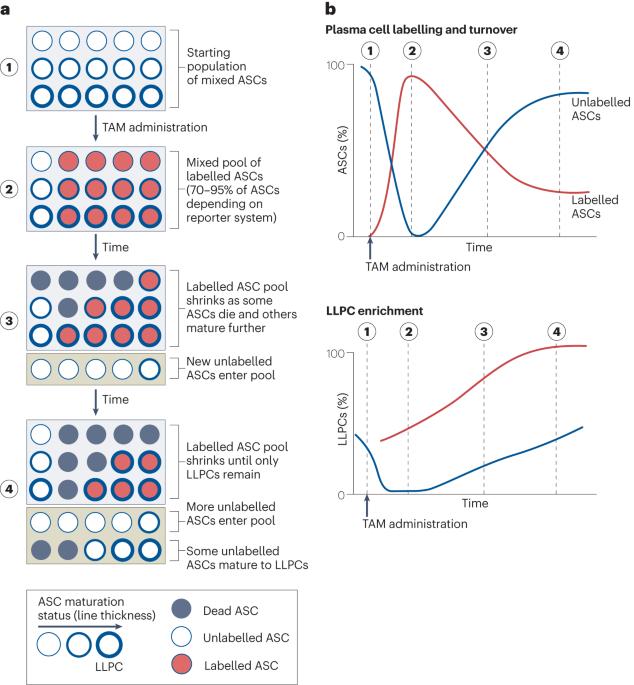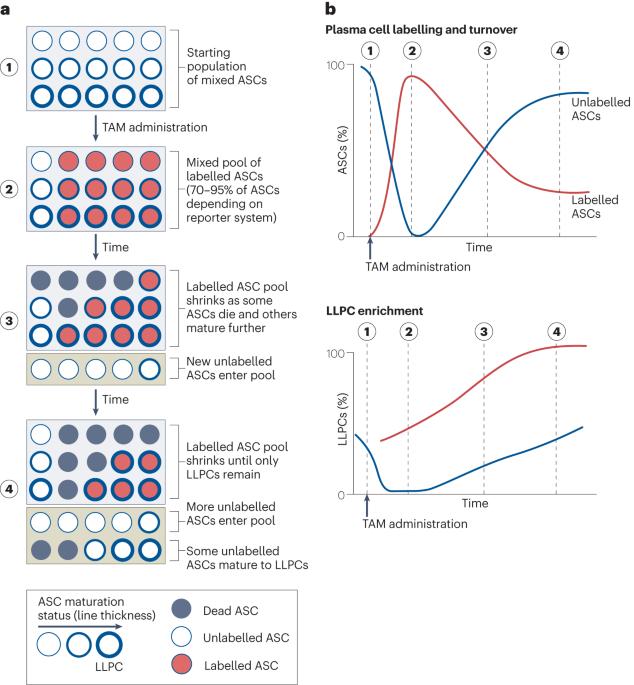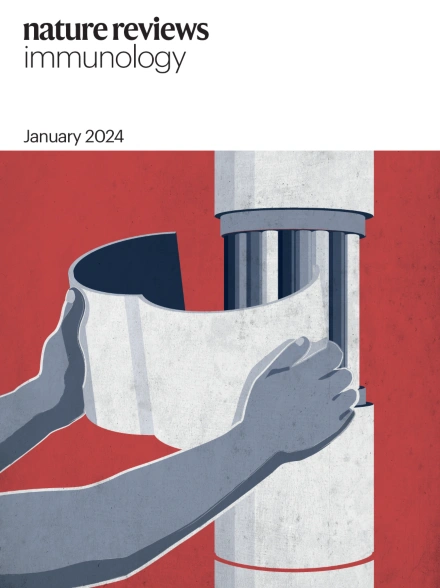对长寿命浆细胞的发生、多样性、成熟和存活的新认识。
IF 67.7
1区 医学
Q1 IMMUNOLOGY
引用次数: 0
摘要
浆细胞是一种独特的免疫效应器,能够产生大量高亲和力抗体,抵御病原体感染。虽然大多数浆细胞的寿命都很短,但在某些情况下或接种疫苗后会产生长寿命浆细胞(LLPCs),为个体提供终生保护,使其免受病原体感染。人们对这些长寿命浆细胞的性质知之甚少;不过,最近的研究对这些独特细胞的本体、多样性、成熟和存活有了新的认识。过去人们认为 LLPCs 优先产生于生殖中心,而新的基因工具揭示了它们可以产生于整个体液反应的不同阶段。此外,新的单细胞分析表明,小鼠和人类浆细胞具有异质性,可能在骨髓龛原位进一步成熟。最后,浆细胞以前被认为是维持在固定生存龛中的无柄细胞,但新的数据显示,浆细胞亚群可以以不同方式迁移并组织成可能与生存龛相关的集群。这些描述性发现为细胞内在程序和外在因素如何在各种情况下调节浆细胞的寿命提供了新的见解,为其功能验证提供了新的研究途径。本文章由计算机程序翻译,如有差异,请以英文原文为准。



New insights into the ontogeny, diversity, maturation and survival of long-lived plasma cells
Plasma cells are unique immune effectors, capable of producing large amounts of high-affinity antibodies that protect against pathogenic infections. Although most plasma cells have short lifespans, certain conditions or vaccinations can give rise to long-lived plasma cells (LLPCs) that provide individuals with lifelong protection against pathogen exposure. The nature of these LLPCs is poorly understood; however, recent studies have shed new light on the ontogeny, diversity, maturation and survival of these unique cells. Whereas LLPCs had been thought to arise preferentially from germinal centres, novel genetic tools have revealed that they can originate from various stages throughout the humoral response. Furthermore, new single-cell analyses have shown that mouse and human plasma cells are heterogeneous and may undergo further maturation in situ in the bone marrow niche. Finally, plasma cells were previously considered to be sessile cells maintained in fixed survival niches, but new data show that plasma cell subsets can differentially migrate and organize into clusters that may be associated with survival niches. These descriptive findings provide new insights into how cell-intrinsic programmes and extrinsic factors may regulate the longevity of plasma cells in various contexts, which suggest new research avenues for their functional validation. In this Progress article, Fooksman and colleagues review recent advances in the study of long-lived plasma cells, using genetic labelling tools, RNA sequencing and in vivo imaging to characterize the differentiation and survival of this rare cell type in mice and humans.
求助全文
通过发布文献求助,成功后即可免费获取论文全文。
去求助
来源期刊

Nature Reviews Immunology
医学-免疫学
CiteScore
93.40
自引率
0.40%
发文量
131
审稿时长
6-12 weeks
期刊介绍:
Nature Reviews Immunology is a journal that provides comprehensive coverage of all areas of immunology, including fundamental mechanisms and applied aspects. It has two international standard serial numbers (ISSN): 1474-1733 for print and 1474-1741 for online. In addition to review articles, the journal also features recent developments and new primary papers in the field, as well as reflections on influential people, papers, and events in the development of immunology. The subjects covered by Nature Reviews Immunology include allergy and asthma, autoimmunity, antigen processing and presentation, apoptosis and cell death, chemokines and chemokine receptors, cytokines and cytokine receptors, development and function of cells of the immune system, haematopoiesis, infection and immunity, immunotherapy, innate immunity, mucosal immunology and the microbiota, regulation of the immune response, signalling in the immune system, transplantation, tumour immunology and immunotherapy, and vaccine development.
 求助内容:
求助内容: 应助结果提醒方式:
应助结果提醒方式:


